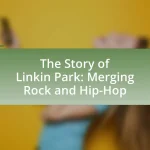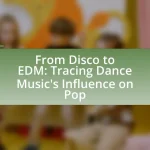The article examines the origins and evolution of Indie Pop, a genre that emerged in the late 1970s and early 1980s as a subgenre of alternative rock, characterized by its DIY ethos and melodic sound. It explores the historical context that influenced its development, including the punk rock movement and the rise of independent record labels. Key artists such as The Smiths, R.E.M., and Belle and Sebastian are highlighted for their pivotal roles in shaping the genre. The article also discusses the musical characteristics, lyrical themes, and the impact of technology and cultural shifts on Indie Pop’s evolution, as well as current trends and challenges faced by contemporary artists in the genre.
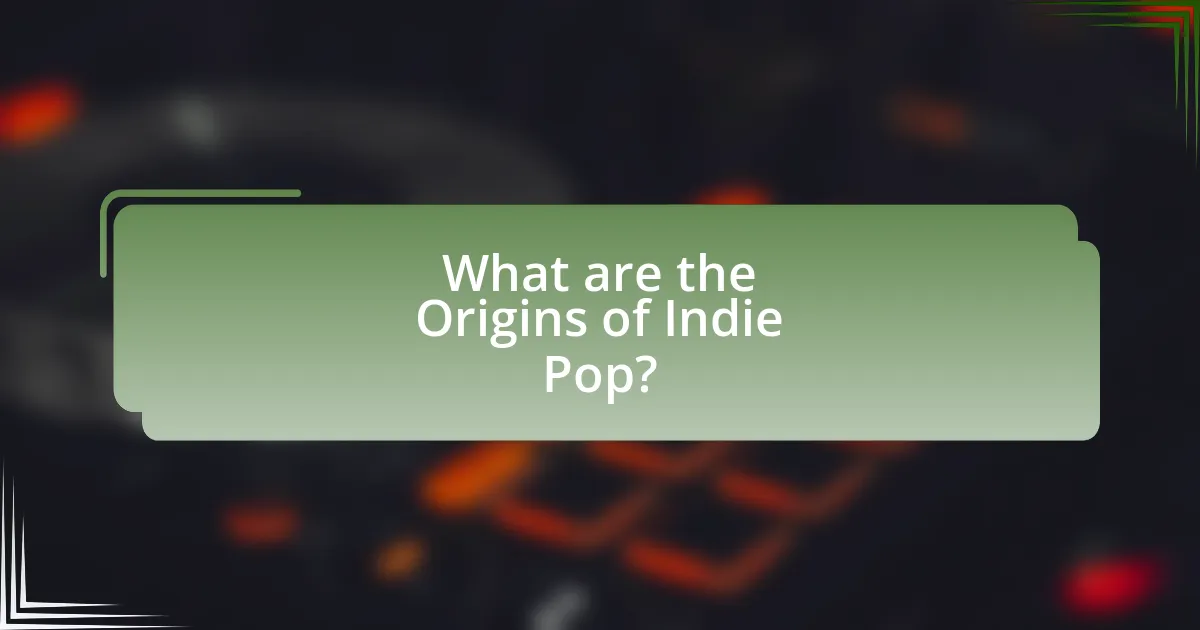
What are the Origins of Indie Pop?
Indie pop originated in the late 1970s and early 1980s as a subgenre of alternative rock, characterized by its DIY ethos and a focus on melodic, catchy tunes. The genre emerged from the independent music scene, particularly in the UK, where bands like The Smiths and Orange Juice began to gain popularity outside of mainstream music channels. This movement was fueled by the rise of independent record labels, such as Creation Records and 4AD, which provided a platform for artists to produce and distribute their music without the constraints of major labels. The term “indie pop” itself became widely used in the 1980s to describe this distinct sound and approach to music-making, emphasizing artistic freedom and a rejection of commercialism.
How did the term ‘Indie Pop’ come into existence?
The term ‘Indie Pop’ emerged in the 1980s to describe a genre of music produced by independent record labels, distinguishing it from mainstream pop music. This classification arose as artists sought to create music outside the commercial constraints of major labels, emphasizing a DIY ethos and a more personal, artistic approach. The term gained traction as bands like The Smiths and Belle and Sebastian exemplified this sound, blending melodic pop with an independent spirit. The rise of independent labels and the growing popularity of college radio further solidified ‘Indie Pop’ as a recognized genre, reflecting a cultural shift towards valuing artistic integrity over commercial success.
What historical events influenced the birth of Indie Pop?
The birth of Indie Pop was influenced by the punk rock movement of the late 1970s, which emphasized DIY ethics and independent music production. This movement led to the establishment of independent record labels, allowing artists to create and distribute music outside of the mainstream music industry. Additionally, the rise of alternative rock in the 1980s, characterized by bands like R.E.M. and The Smiths, further shaped the sound and ethos of Indie Pop. The cultural shifts of the 1980s, including the rise of college radio and the increasing accessibility of music technology, also played a significant role in promoting Indie Pop’s emergence as a distinct genre.
Which artists were pivotal in the early development of Indie Pop?
The artists pivotal in the early development of Indie Pop include The Smiths, R.E.M., and Belle and Sebastian. The Smiths, active in the 1980s, are often credited with shaping the genre’s sound through their jangly guitars and introspective lyrics. R.E.M., emerging in the same era, blended alternative rock with pop sensibilities, influencing countless bands. Belle and Sebastian, formed in the 1990s, brought a melodic and narrative-driven approach to Indie Pop, further defining its characteristics. These artists collectively laid the groundwork for the genre, establishing key elements that would influence future musicians.
What musical characteristics define Indie Pop?
Indie Pop is characterized by its melodic hooks, jangly guitars, and often introspective lyrics. This genre typically features a DIY ethos, with artists often self-producing their music or working with independent labels. The sound is generally lighter and more accessible than other genres, incorporating elements from various styles such as rock, pop, and electronic music. Notably, Indie Pop often emphasizes catchy choruses and a focus on songwriting, which can be traced back to influences from 1960s pop and 1980s alternative music.
How do instrumentation and production techniques shape Indie Pop sound?
Instrumentation and production techniques significantly shape the Indie Pop sound by emphasizing melodic structures and unique sonic textures. Indie Pop often utilizes a diverse range of instruments, including guitars, synthesizers, and unconventional percussion, which contribute to its distinctive sound. For instance, the use of jangly guitars and airy synths creates a light, melodic atmosphere that is characteristic of the genre.
Production techniques such as lo-fi recording, layering of vocals, and the use of reverb enhance the emotional depth and intimacy of the music. Artists like Sufjan Stevens and Tame Impala exemplify this, as they incorporate intricate arrangements and experimental sounds that push the boundaries of traditional pop. The blending of these elements allows Indie Pop to maintain a sense of authenticity while appealing to a broader audience, thus shaping its evolution and defining its unique identity within the music landscape.
What lyrical themes are commonly found in Indie Pop music?
Lyrical themes commonly found in Indie Pop music include introspection, nostalgia, love, and existentialism. These themes often explore personal experiences and emotions, reflecting a sense of individuality and authenticity. For instance, introspective lyrics frequently delve into self-discovery and personal growth, while nostalgic themes evoke memories and past relationships. Love is portrayed in various forms, from romantic to platonic, often emphasizing vulnerability and connection. Existentialism in Indie Pop raises questions about life, purpose, and identity, resonating with listeners seeking deeper meaning. This thematic diversity contributes to the genre’s appeal and relatability, making it a significant aspect of Indie Pop’s identity.
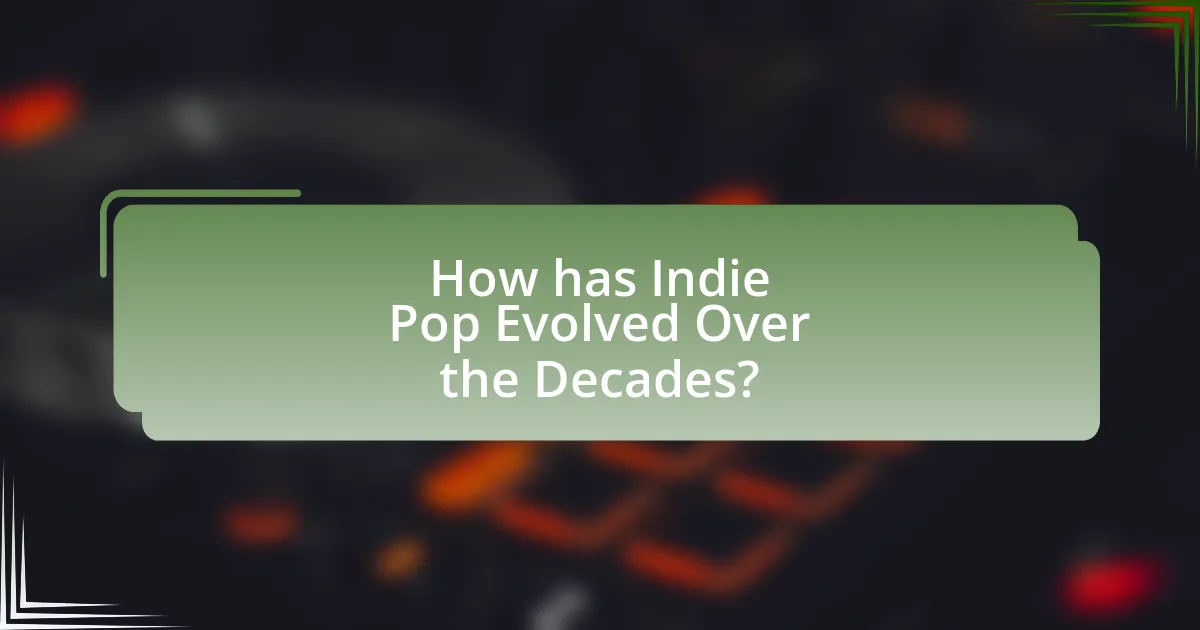
How has Indie Pop Evolved Over the Decades?
Indie pop has evolved significantly over the decades, transitioning from a niche genre in the 1980s to a mainstream phenomenon by the 2010s. In the 1980s, indie pop emerged as a reaction against the commercialism of mainstream music, characterized by DIY ethics and a lo-fi sound, with bands like The Smiths and The Vaselines leading the way. The 1990s saw the genre gain traction with the rise of alternative rock, as bands like Belle and Sebastian and Neutral Milk Hotel incorporated more diverse influences, blending folk and pop sensibilities.
By the 2000s, indie pop began to incorporate electronic elements and production techniques, with artists such as The Postal Service and Sufjan Stevens pushing the boundaries of the genre. The 2010s marked a peak in indie pop’s popularity, with artists like Vampire Weekend and Tame Impala achieving commercial success while maintaining an independent ethos. This evolution reflects broader cultural shifts, including the rise of digital distribution and social media, which have allowed indie artists to reach wider audiences without traditional label support.
What major trends have influenced the evolution of Indie Pop?
The major trends that have influenced the evolution of Indie Pop include the rise of digital technology, the DIY ethos, and the blending of genres. Digital technology has enabled artists to produce and distribute music independently, leading to a surge in the number of Indie Pop artists. The DIY ethos, which emphasizes self-production and grassroots promotion, has been pivotal since the genre’s inception in the 1980s, allowing musicians to maintain creative control. Additionally, the blending of genres, particularly with elements from rock, electronic, and folk music, has expanded the sound and appeal of Indie Pop, making it more diverse and accessible to a wider audience. These trends collectively reflect the genre’s adaptability and its response to cultural shifts in music consumption and production.
How did the rise of technology impact Indie Pop music production?
The rise of technology significantly transformed Indie Pop music production by democratizing access to high-quality recording tools and software. This shift allowed independent artists to produce music at home, reducing reliance on expensive studio time and enabling a more diverse range of sounds and styles. For instance, the advent of digital audio workstations (DAWs) like Ableton Live and GarageBand provided musicians with user-friendly interfaces and powerful editing capabilities, which were previously only available in professional studios. As a result, many Indie Pop artists began to experiment with production techniques, leading to innovative sounds that characterized the genre in the 2000s and beyond. This technological evolution not only facilitated the creative process but also contributed to the proliferation of Indie Pop, as artists could easily distribute their music online, reaching global audiences without traditional gatekeepers.
What role did the internet play in the dissemination of Indie Pop?
The internet played a crucial role in the dissemination of Indie Pop by providing a platform for independent artists to share their music without the constraints of traditional record labels. This democratization of music distribution allowed for a wider reach and accessibility, enabling artists to connect directly with audiences globally. For instance, platforms like Bandcamp and SoundCloud emerged as vital tools for Indie Pop musicians, facilitating the sharing of their work and fostering community engagement. Additionally, social media platforms such as Facebook and Twitter enabled artists to promote their music and build fan bases, significantly contributing to the genre’s growth and visibility. The rise of streaming services further amplified this effect, allowing listeners to discover and explore Indie Pop artists easily, thus solidifying the internet’s pivotal role in the genre’s evolution.
How have cultural shifts affected Indie Pop’s evolution?
Cultural shifts have significantly influenced Indie Pop’s evolution by altering its themes, sounds, and audience engagement. For instance, the rise of digital technology and social media has democratized music distribution, allowing Indie Pop artists to reach wider audiences without traditional label support. This shift has led to a more diverse range of voices and styles within the genre, as seen in the emergence of artists like Billie Eilish and Phoebe Bridgers, who blend various influences and address contemporary issues such as mental health and identity. Additionally, cultural movements, such as the push for inclusivity and representation, have prompted Indie Pop to embrace a broader spectrum of experiences, further enriching its landscape.
What social movements have influenced the themes in Indie Pop music?
Social movements such as feminism, LGBTQ+ rights, and environmental activism have significantly influenced the themes in Indie Pop music. Feminism has shaped lyrical content, promoting messages of empowerment and gender equality, as seen in the works of artists like Florence Welch and Lizzo. LGBTQ+ rights movements have inspired themes of love, identity, and acceptance, prominently featured in songs by artists like Troye Sivan and Hayley Kiyoko. Environmental activism has led to a focus on sustainability and climate change, reflected in the music of bands like The 1975. These movements have provided a rich context for Indie Pop, allowing artists to address social issues and connect with audiences on a deeper level.
How has the audience for Indie Pop changed over time?
The audience for Indie Pop has expanded significantly over time, transitioning from a niche group to a broader demographic. In the early 2000s, Indie Pop primarily attracted college students and music enthusiasts who sought alternatives to mainstream pop. By the 2010s, the genre gained popularity through digital platforms and social media, reaching a diverse audience that includes younger listeners and mainstream music fans. This shift is evidenced by the rise of streaming services, where Indie Pop playlists have millions of followers, indicating a wider acceptance and appreciation of the genre across various age groups and cultural backgrounds.
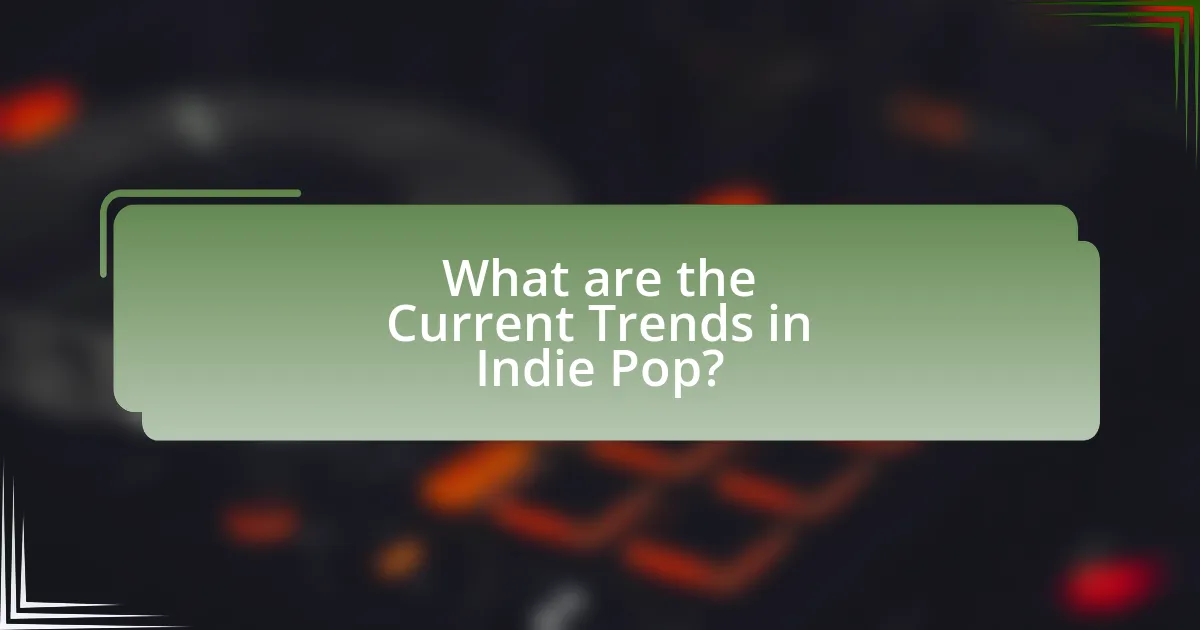
What are the Current Trends in Indie Pop?
Current trends in indie pop include a blend of lo-fi production, genre fusion, and increased use of digital platforms for distribution. Artists are increasingly incorporating elements from various genres such as electronic, hip-hop, and folk, creating a more eclectic sound. The rise of social media platforms like TikTok has also influenced the genre, allowing songs to gain popularity rapidly through viral trends. Additionally, there is a notable emphasis on authenticity and personal storytelling in lyrics, reflecting broader cultural movements towards mental health awareness and social issues. These trends are supported by data showing that indie pop streams have significantly increased on platforms like Spotify, indicating a growing audience for this genre.
What contemporary artists are shaping the current Indie Pop scene?
Contemporary artists shaping the current Indie Pop scene include Phoebe Bridgers, Clairo, and Tame Impala. Phoebe Bridgers has gained recognition for her introspective lyrics and unique sound, exemplified by her critically acclaimed album “Punisher,” which was nominated for multiple Grammy Awards in 2021. Clairo, known for her bedroom pop aesthetic, has made waves with her debut album “Immunity,” which showcases her ability to blend personal storytelling with catchy melodies. Tame Impala, led by Kevin Parker, has influenced the genre with its psychedelic sound and innovative production techniques, particularly evident in the album “The Slow Rush,” which debuted at number one on the Billboard 200 chart. These artists are not only defining the sound of Indie Pop today but also pushing its boundaries through their distinct styles and approaches.
How do modern Indie Pop artists differ from their predecessors?
Modern Indie Pop artists differ from their predecessors primarily in their use of technology and genre blending. Contemporary artists leverage digital platforms for production, distribution, and promotion, allowing for greater accessibility and reach compared to earlier artists who relied on traditional record labels and physical media. Additionally, modern Indie Pop often incorporates diverse influences from various genres, such as electronic, hip-hop, and world music, creating a more eclectic sound. This evolution reflects a shift in listener preferences and the availability of tools that enable experimentation, as seen in the rise of artists like Billie Eilish and Tame Impala, who blend styles and utilize home recording technology to produce their music.
What collaborations are emerging within the Indie Pop genre today?
Emerging collaborations within the Indie Pop genre today include partnerships between established artists and newcomers, such as the collaboration between Phoebe Bridgers and Conor Oberst, which has gained significant attention for its unique sound. Additionally, artists like Clairo and Olivia Rodrigo have been working together, blending their distinct styles to create fresh tracks that resonate with younger audiences. These collaborations reflect a trend where artists are increasingly seeking to merge their creative visions, resulting in innovative music that pushes the boundaries of the genre.
What are the challenges facing Indie Pop artists today?
Indie Pop artists today face significant challenges, including market saturation, limited financial resources, and difficulties in gaining mainstream visibility. The rise of digital platforms has led to an overwhelming number of artists competing for attention, making it harder for individual Indie Pop musicians to stand out. Additionally, many Indie Pop artists operate on tight budgets, which restricts their ability to invest in marketing, production, and touring. According to a 2021 report by the Music Industry Research Association, 70% of independent artists reported financial constraints as a major barrier to their success. Furthermore, the algorithms of streaming services often favor established artists, making it challenging for emerging Indie Pop musicians to reach wider audiences.
How do Indie Pop artists navigate the music industry landscape?
Indie Pop artists navigate the music industry landscape by leveraging digital platforms for distribution and promotion. These artists often utilize social media, streaming services, and independent record labels to reach their audience directly, bypassing traditional industry gatekeepers. For instance, platforms like Bandcamp and SoundCloud allow them to share their music without significant upfront costs, enabling a more democratic approach to music distribution. Additionally, data from the Recording Industry Association of America (RIAA) indicates that independent labels accounted for 35% of the U.S. music market in 2021, highlighting the growing influence and viability of indie artists in the industry.
What strategies can Indie Pop artists use to reach wider audiences?
Indie Pop artists can reach wider audiences by leveraging social media platforms, collaborating with other musicians, and engaging in live performances. Social media platforms like Instagram, TikTok, and YouTube allow artists to share their music and connect with fans directly, which is crucial as 90% of music discovery now occurs online. Collaborations with other artists can introduce Indie Pop musicians to new fan bases, as seen in successful partnerships like those between Billie Eilish and Khalid. Additionally, live performances, whether virtual or in-person, create memorable experiences that can enhance audience engagement and loyalty, with studies showing that 70% of concertgoers discover new music at live events.
What are the Best Practices for Emerging Indie Pop Artists?
Emerging indie pop artists should focus on building a strong online presence, engaging with their audience, and collaborating with other musicians. A robust online presence includes utilizing social media platforms like Instagram, TikTok, and YouTube to share music, behind-the-scenes content, and personal stories, which can help in creating a loyal fanbase. Engaging with the audience through live streams, Q&A sessions, and responding to comments fosters a sense of community and connection. Collaborating with other artists can expand reach and introduce new sounds, as seen in successful partnerships within the indie pop genre. According to a 2021 report by the International Federation of the Phonographic Industry, artists who actively engage with their audience online see a 30% increase in fan retention.
How can new artists effectively promote their music in the digital age?
New artists can effectively promote their music in the digital age by leveraging social media platforms, streaming services, and targeted online marketing strategies. Social media platforms like Instagram, TikTok, and Twitter allow artists to engage directly with fans, share content, and build a community around their music. Streaming services such as Spotify and Apple Music provide opportunities for playlist placements, which can significantly increase visibility and listener engagement. Additionally, targeted online marketing strategies, including email newsletters and digital ads, enable artists to reach specific demographics and promote new releases effectively. According to a 2021 report by the International Federation of the Phonographic Industry, 70% of music consumption now occurs through streaming, highlighting the importance of these platforms in modern music promotion.
What resources are available for aspiring Indie Pop musicians?
Aspiring Indie Pop musicians can access a variety of resources including online platforms, music production software, and community support networks. Online platforms such as Bandcamp and SoundCloud allow musicians to share their music and connect with audiences directly. Music production software like Ableton Live and GarageBand provides tools for creating and recording music at home. Additionally, community support networks, including local music collectives and social media groups, offer opportunities for collaboration, feedback, and promotion. These resources collectively empower Indie Pop musicians to develop their craft and reach wider audiences.

